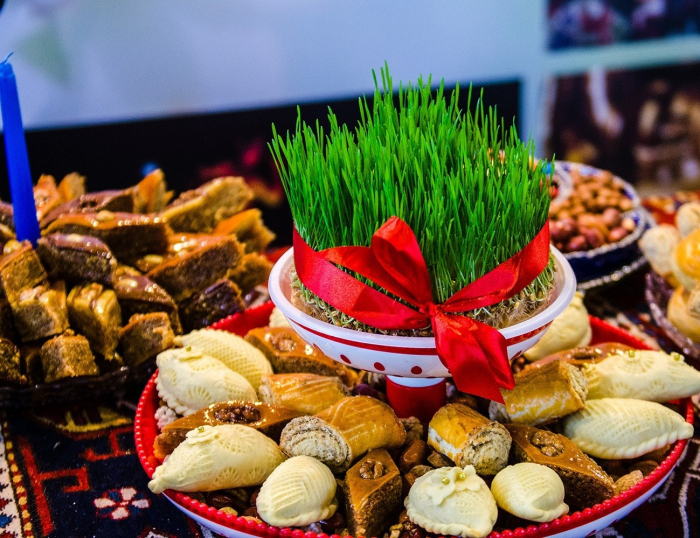Rather than fading from relevance, the values of this ancient festival – from taking a yearly reset to connecting with nature in a precarious time – are now more important than ever.
It's the season of Nowruz, the annual 13-day festival that marks the start of spring, and millions of people all over the world with roots in the former Persian Empire are celebrating.
Persia, anchored in modern-day Iran, once stretched from Afghanistan and Pakistan in the east to Egypt and the Balkan Peninsula in the west, and it left behind an enduring cultural legacy that includes this vibrant celebration. Despite Nowruz dating back 3,500 years, celebrants believe that rather than fading from relevance, the lessons of Nowruz – from taking a yearly reset to valuing family to connecting with nature in a precarious time – are now more important than ever.
Nowruz was originally a Zoroastrianismholiday, part of the ancient monotheistic religion founded by the prophet Zoroaster in approximately 500 BCE. In the time of the Persian Empire (roughly 559-331 BCE), the rulers of all of the subject countries were summoned at Nowruz to bring gifts and pay homage to the king at Persepolis, the ruins of which remain in the Iranian city of Shiraz. In this way, the kings could show the ancestors that they were prospering, something that remains an important aspect of the holiday.
Zoroastrianism remained the official state religion of the Persian Empire for centuries until the Arab conquest around 632 CE, after which it became Muslim. But Nowruz was firmly established, and even under Islamic rule it remained, evolving over time into a secular holiday celebrated by all faiths, including Christians, Jews and Muslims. Today, Iran, along with Afghanistan, Azerbaijan, India, Pakistan, Turkey, Uzbekistan and other countries once under Persian influence, observe Nowruz, as well as diaspora communities in North America, Europe and elsewhere around the world.
As these traditions have spread, Nowruz has been welcomed into the Western mainstream. Last year, Disney released an animation of Mickey Mouse explaining Nowruz. Major American publications regularly feature Nowruz food stories and recipes. And the travelling dance party Disco Tehran, fuelled by its popularity in Los Angeles and New York, will hold Nowruz bashes this year in Berlin, Paris and London.
Nowruz, which means "new day" in Persian, starts at the moment of the spring equinox when the sun passes over the equator on its way north. This year, it kicks off on 20 March at 06:36 in Tehran and 03:06 in London, and on 19 March at 23:06 in New York.
Nowruz customs around the world have unique traits. In Afghanistan, people eat a dessert made of seven different dried fruits and nuts soaked in syrup called mewa. In Tajikistan and Kyrgyzstan, vessels are placed around the house and filled with water before the clock strikes the new year. And in Afghanistan, riders on horseback play the national sport buzkashi, similar to polo but using the body of a goat instead of a ball.
For Haleh Esfandiari, founding director of the Middle East Program at the Woodrow Wilson International Center for Scholars in Washington DC, it's this welcoming, inclusive nature of the holiday that has made Nowruz so enduring, "It is not just a celebration of the new year; it serves as the bond that brings all Iranians together – precisely because it is a national, not a religious, celebration. Iranians of diverse religions and ethnic and tribal identities all celebrate Nowruz," she said.
Symbolically, Nowruz is about rebirth and new beginnings. While the holiday of Nowruz kicks off at the equinox, preparations begin weeks before. In order to enter the new year on the right foot, it's important to have both a spotless home and a clear conscience.
The first step is cleaning the home from top to bottom, a practice called khoone takoone, which translates to "shaking the house" in Persian. It's also important to resolve outstanding grudges by making amends to the wronged party with a gift of ajeel, a mix of dried fruit and nuts. It's customary to sprout lentils and wheat during the weeks prior, mirroring the shoots and buds emerging outside. Then, on the Wednesday before Nowruz, everyone from children to grandparents jumps over a bonfire. This is to purge any negativity from the past year.
With its hopeful message of new beginnings, Nowruz offers a valuable opportunity to recharge. The British cookbook author and broadcaster Yasmin Khan, whose mother is from Iran, sees it as the start of her year. "I gain a lot of strength from the rituals and symbolism of the spring cleaning, the growing of the sprouts, jumping over fires," she said. "They give me a sense of grounding, connecting me to my ancestral culture and also to the seasons and the elements."
Nowruz is an occasion for honouring family, both ancestors and the living, and people visit one another and feast together. For Anna Fahr, an Iranian Canadian filmmaker, the social connection is the most important part of Nowruz, something that is especially important after the Covid pandemic. "I like to talk with people. It's a nice reason to reconnect with my relatives," she said. "With friends in other places we do an online fire jump. We'll each set up candles in our apartments and all jump over them together. It's very much about communal gatherings. Getting together as family and friends."
On the final day of Nowruz, it's customary to pack a picnic, head into the countryside and toss the lentil and wheat sprouts into moving water, signalling a break with the previous year. It's a day to spend time appreciating the outdoors after the long winter. For Persis Karim, director of the Center for Iranian Diaspora Studies at San Francisco State University, Nowruz is a reminder of our symbiotic relationship with the natural world. "The transition of the seasons at the same time each year has been imprinted in us through this ritualised holiday," she said.
However, due to climate change, the way that people have observed Nowruz for thousands of years is being altered, and this undeniable evidence could be a catalyst for people to pay attention. "Everywhere you look there are rising temperatures, lack of water, the depletion of natural species," Karim said. "The blossoms are coming out a lot earlier. Nowruz is now in some ways under threat, and it could be linked to an understanding about the vulnerability of our planet and our participation in that vulnerability."
Nowruz is now in some ways under threat, and it could be linked to an understanding about the vulnerability of our planet and our participation in that vulnerability
Perhaps what Nowruz celebrants value the most is the life-affirming quality of the holiday rituals, at a time when issues like climate change, world politics and social isolation are causes for anxiety. For Rebecca Rahimi, a New York-based television producer, Nowruz is an excuse to slow down and simply enjoy life. "It's the first day of spring, there's sunlight, we're at one with the Earth. You're supposed to go to the park and picnic. There's a sense of freedom," she explained.
Rahimi feels a deep connection to the holiday and celebrates every year, even if she's away from her family. "I get my non-Persian friends together and we go to Disco Tehran every year. It's fun!" she said.
In 2024, as Nowruz gets underway amid rampant global uncertainty, the festival may bring a moment of peace for its celebrants.
BBC
More about:
















































